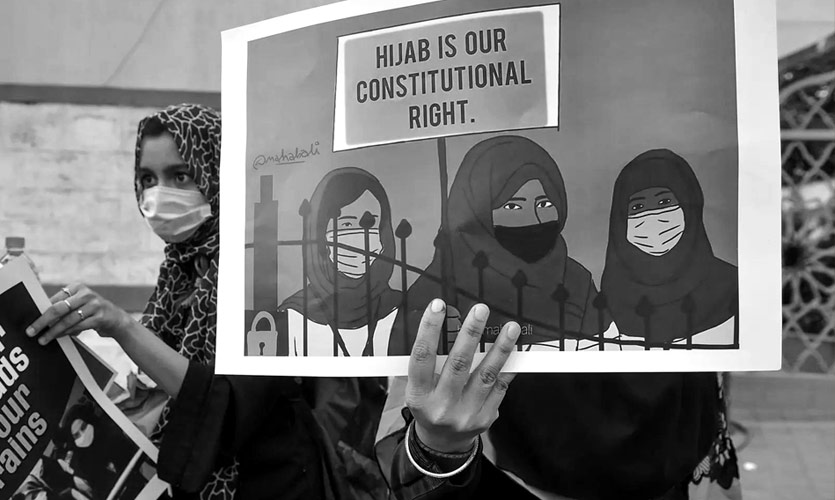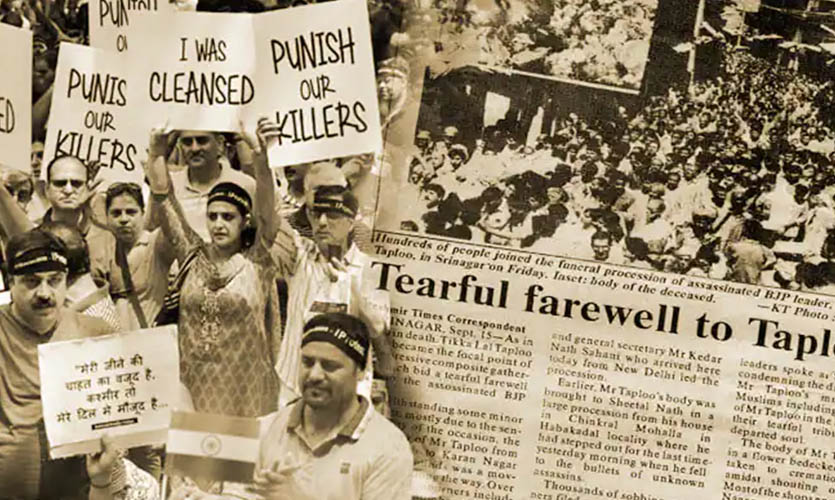The hijab controversy in Karnataka has garnered national attention, with young Muslim girls insisting that it is their constitutional right to be able to wear it in the classroom. Is it though?
The country has ignited in extensive debate over the constitutional validity of wearing the hijab in a school or college that has a dress code/uniform. Experts across academic, legal, and religious lines have something or the other to add to what citizens personally believe. While the Karnataka High Court continues to deliberate on it, the issue has taken centre stage amid the international community. Is it perhaps time to put these repetitive heated arguments to rest once and for all, and enact the uniform civil code as was initially intended by the pioneers of the Indian constitution?
TL; DR
On December 31, 2021, six girls were denied entry into Udupi Women’s Pre-University College in Karnataka, for wearing hijabs. The girls were not allowed to enter as wearing the hijab in classrooms is against the institution’s dress code. “The rule is being followed to ensure uniformity in classrooms,” Rudra Gowda, the college principal, had said. However, the girls remained adamant. On January 3, some Hindu students of the First Grade College in Chikmagalur responded by coming to the institution wearing saffron scarves, giving rise to a serious confrontation between the two groups. Similar scenes were witnessed in the Pompei College of Mangalore, on January 6. Karnataka Primary and Secondary Education Minister BC Nagesh also said that the state was considering the implementation of a uniform dress code.
On January 31, 2022, a Muslim girl filed a writ petition in the Karnataka High Court, stating that wearing the hijab is her fundamental right under Articles 14 and 25 of the constitution, and an essential part of Islam. Students of the Udupi Women’s PU College appealed that the court let them attend classes wearing hijab, in the interim. The Karnataka government asked all students and institutions to maintain the status quo until a recommendation was released. On February 2, the Kundapur Government PU College shut its gates on students as some showed wearing hijabs and some in saffron scarves. This was followed by similar events at the Sir M Vishweshwaraiah Government Arts and Commerce College in Shivamogga on the same day, and the Bhandarkar’s Arts & Science College on February 3.
The matter was first heard on February 8 by Justice Krishna Dixit, with Senior Advocate Devadutt Kamat appearing for the petitioners. On February 9, the single-judge bench referred the matter to a larger bench comprising Justice Dixit and Justice JM Khazi, and Chief Justice Ritu Raj Awasthi. In the interim order of February 10, the bench said that the hijab will not be allowed inside classrooms that have a pre-defined dress code. The order said, “Pending consideration of all these petitions, we restrain all the students regardless of their religion or faith from wearing saffron shawls (bhagwa) scarfs, hijab, religious flags or the like, within the classroom, until further orders.” The Karnataka HC has been hearing pleas ever since. Chief Minister Basavaraj Bommai has clarified that the interim order does not apply to all colleges in the state. “The high court order will not be followed in all colleges. HC has said only colleges where uniforms are prescribed, a ban will apply,” he said. Following this order, all high schools and colleges were shut across the state, and the court continued to hear petitions.
On February 14, the BJP-led administration decided to reopen institutions on February 16, in a high-level meeting chaired by the chief minister. Some high schools in the state had already resumed on Monday. The next day, on February 15, advocates appearing for the petitioners told the court that the interim order had been “grossly misused”, leading to suspension of their clients’ fundamental rights. Advocate Mohammed Tahir said, “The order passed by the High Court has been grossly misused. They are using this order in every institution. Muslim girls are being forced to remove their hijabs.” His memo was rejected by the court since a lot of the petitioners were signatories. Advocate Kamat added that a “small exemption will be in line with freedom of expression”. Citing judgements from Canada, South Africa, and the UK, he said that wearing the hijab is “an innocuous practice, which is completely protected by Article 25”.
On February 17, the Karnataka High Court dismissed one of the petitions saying, “We will dismiss this petition. It is not maintainable. We will dismiss your petition with costs. You are testing our nerves.” The court adjourned the hearings after Advocate General Prabhuling Navadgi appearing for the state sought time to review and respond to the petitions filed by the Udupi Women’s PU College. It is set to resume hearing the pleas on Friday.
International Interference
On February 8, Pakistani activist Malala Yousafzai, alleging that Muslim girls were being asked to choose between hijab and studies, tweeted, “Refusing to let girls go to school in their hijabs is horrifying. Objectification of women persists — for wearing less or more. Indian leaders must stop the marginalisation of Muslim women.” A champion of education for girls and the youngest Nobel laureate, Yousafzai was shot by a Tehrik-i Taliban Pakistan (TTP) gunman in retaliation for her activism. In chapter 13 of her book, ‘I am Malala’, Yousafzai narrates, “I loved my royal-blue school uniform but we were advised to wear plain clothes instead and hide our books under our shawls.” The TTP was internationally condemned for attempting to assassinate her for pursuing education and flouting oppressive norms in the name of religious obligation. “My school uniform is very important to me because when I was going to school I would wear it. The day I was attacked I was wearing this uniform. I was fighting for my right to go to school, I was fighting for my right to get education. Wearing a uniform made me feel that yes, I am a student, I am doing it, practically,” said Yousafzai in her interview with the Nobel Peace Center in 2014, while explaining why she wanted to display her bloodstained uniform.
“Today the ban is on Hijab, tomorrow it will be Azan, Namaz, and then Quran. Now is the time to stand up for Urduistan — a Muslim dominated country,” said Gurpatwant Singh Pannu, General Counsel of the pro-Khalistan group Sikhs For Justice (SFJ). The SFJ head appealed to the Muslims of India to demand a “Hijab referendum” in the areas of Bihar, Delhi, Rajasthan, UP, and West Bengal, to carve out “Urduistan”.
Indian intelligence agencies are exploring the possibility of Pakistan funding the protests in Karnataka as at least 100 Twitter accounts have popped in the name of protester Muskan Khan, and most of the tweets by which have originated from Pakistan. Muskan Khan is a Muslim girl student who can be seen wearing a burqa and chanting ‘Allah-hu-Akbar’ in a video that went viral across the globe. Pakistani Foreign Minister Shah Mahmood Qureshi also termed the events in Karnataka as an attempt to ghettoise the Muslim community in India.
Amid these interferences, the Organisation of Islamic Countries (OIC) expressed “deep concerns” over the “continued attacks targeting Muslims and their places of worship” in India. “The OIC General Secretariat further urges once again India to ensure the safety, security and wellbeing of the Muslim community while protecting the way of life of its members and to bring the instigators and perpetrators of acts of violence and hate crimes against them to justice,” said the organisation in a statement. “We have noted yet another motivated and misleading statement from the general secretariat of the OIC on matters pertaining to India,” rebutted Arindam Bagchi, the spokesperson for the Ministry of External Affairs of India. “Issues in India are considered and resolved in accordance with our constitutional framework and mechanisms, as well as democratic ethos and polity,” said Bagchi, stating that the OIC is allowing Pakistan to manipulate it.
Why UCC
The uniform civil code (UCC) is listed as one of the Directive Principles of State Policy in Part IV of the Constitution that gives a set of directions to the State but is not the law. Article 44 states, “The State shall endeavour to secure for the citizens a uniform civil code throughout the territory of India.”
The Indian judiciary has expressed the need for UCC time and again. In the final verdict of the Mohd. Ahmed Khan vs Shah Bano Begum And Others (1985) triple talaq case, the Supreme Court had ordered that the petitioner be awarded maintenance, not just under Section 125 of the Indian Penal Code but also the teachings of the Quran. However, the apex court also cited various works in its judgement, including Dr Tahir Mahmood’s book Muslim Personal Law, in which he says, “In pursuance of the goal of secularism, the State must stop administering religion based personal laws.” It perceives that a common law “will help the cause of national integration by removing disparate loyalties to laws which have conflicting ideologies”. Moreover, Article 31C, added to the constitution by the 42nd Amendment in 1976 (during the Indira Gandhi government), states that if a law is made to enact any of the directive principles, “it cannot be challenged on the ground of being violative of the Fundamental Rights under Articles 14 and 19”.
Reiterating the views of the highest court of India, the Allahabad High Court placed the onus on the Centre and said, “It is the State which is charged with the duty of securing a uniform civil code for the citizens of the country and, unquestionably, it has the legislative competence to do so.” While granting relief to 17 inter-faith couples, on November 18, 2021, the court emphasised that UCC “is a necessity and mandatorily required today”. It directed the Centre to consider constituting a committee and beginning the process of implementation.
“Constitution has given the right to practice any religion which means one can wear any clothes according to their religion. Prohibiting hijab-wearing students from entering school is a violation of fundamental rights. The main agenda of the Sangh Parivar is to deny education to Muslim girls in the name of hijab,” said Siddaramaiah, Leader of the Opposition in Karnataka Assembly, on February 6. The argument is flawed since the religious book followed by the Muslim community, the Quran, does not necessitate the hijab. As Advocate General Navadgi argued, citing the precedent of the triple talaq case, the practice of hijab is stated in the Hadith, which is to be considered a secondary source.
A state of panic has ensued regardless, as it historically does in the country when UCC is mentioned. But how are we to reform our society if we continue to hold personal laws and religion above the purview of the law, and equality before it? While explaining the same during the proceedings of the Constituent Assembly of India Debates (Volume 7) in December 1948, Dr BR Ambedkar has said, “…No one need be apprehensive of the fact that if the State has the power, the State will immediately proceed to execute or enforce that power in a manner that may be found to be objectionable by the Muslims or by the Christians or by any other community in India.” Like Akshaya Chintala explains in her paper, “The state does not have a religion of its own… and though irreligious is not anti-religious.” UCC means a uniform law for all people, and equality for all citizens, leaving little space for leaders such as Karnataka BJP President Nalin Kumar Kateel to say, “There is no space for hijab or such things… Talibanisation will not be allowed.”
Concerning the hijab controversy, the Indian Muslims for Secular Democracy (IMSD), an organisation comprising more than 150 human rights activists, has stated that “the veil is not mandatory in Islam”. “While this may be the belief of the orthodox and patriarchal clerics, any number of modern-day Islamic scholars, men and women, rightly maintain that hijab has nothing to do with the teachings of the Quran and the Prophet. The veil, in other words, is not mandatory in Islam,” said the group. The IMSD has also condemned the “communal polarisation of student campuses”. UCC could also safeguard impressionable minds such as the petitioners in this case from groups seeking to take advantage of their beliefs. The Campus Front of India (CFI), student wing of the Social Democratic Party of India (SDPI), has been linked with the events of the hijab row, however, the petitioners have denied any association. The Popular Front of India (PFI), a National Investigation Agency-designated radical hate group banned by many states, held a ‘unity march’ in Kota (Rajasthan) on February 17, in solidarity with the petitioners. The group is known for its involvement in extremist activities.
Islamic scholars have also argued in recent days that conforming to and championing the practice of hijab is the result of decades of conditioning. “Hijabs, niqabs and burqas have a singular aim of commodifying women as sex objects,” says exiled Bangladesh-origin author Taslima Nasreen. Even if we were to leave national security concerns aside, the motive of oppression is all but proven in statements given by our leaders. “Hijab means parda (veil) in Islam. It is for hiding the beauty of girls when they come of age. Today you can see that the rape rate is the highest in our country. What do you think is the reason for this? The reason is that several women don’t wear hijab,” said Karnataka Congress MLA Zameer Ahmed.
The petitioners, or more aptly, schoolgirls no more than 17 years of age, are protesting for their right of choosing to sit in the classroom and study wearing a hijab. Is it their own choice they are voicing? More importantly, is it really a choice?
The Horus Eye is a weekly column written by Divya Bhan analysing current affairs and policies. This column does not intend or aim to promote any ideology and does not reflect the official position of The Sparrow.
Also read: Does The Demand For A Uniform Civil Code Overlook India’s Religious Freedom?
Also read: Are India’s Educational Institutes Being Leveraged To Forward Political Agendas?










